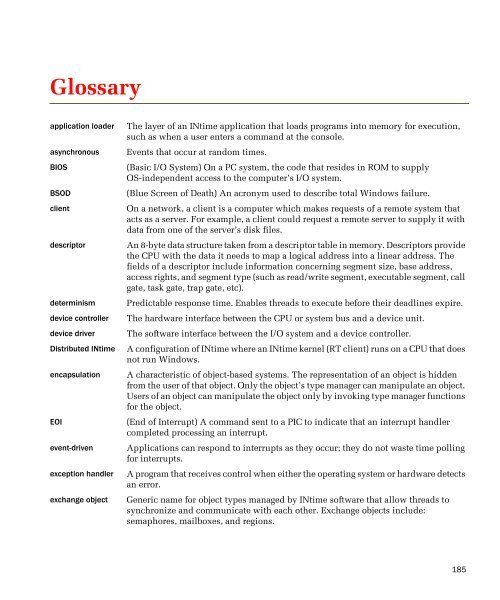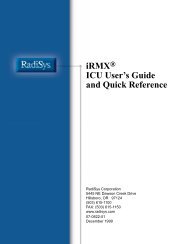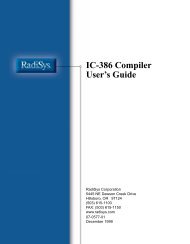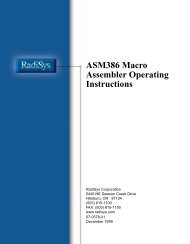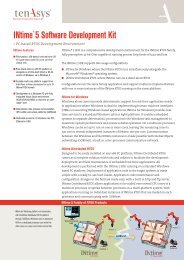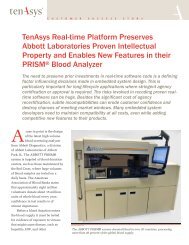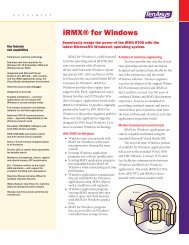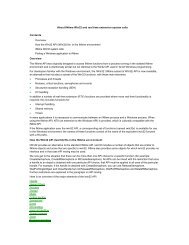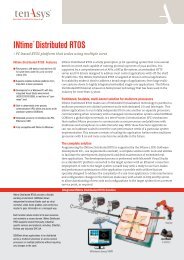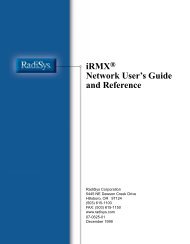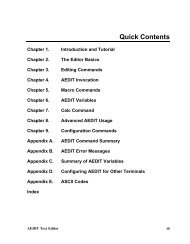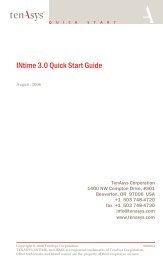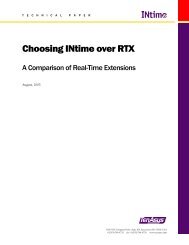INtime® 3.1 Software - tenAsys
INtime® 3.1 Software - tenAsys
INtime® 3.1 Software - tenAsys
Create successful ePaper yourself
Turn your PDF publications into a flip-book with our unique Google optimized e-Paper software.
Glossary<br />
application loader<br />
asynchronous<br />
BIOS<br />
BSOD<br />
client<br />
descriptor<br />
determinism<br />
device controller<br />
device driver<br />
Distributed INtime<br />
encapsulation<br />
EOI<br />
event-driven<br />
exception handler<br />
exchange object<br />
The layer of an INtime application that loads programs into memory for execution,<br />
such as when a user enters a command at the console.<br />
Events that occur at random times.<br />
(Basic I/O System) On a PC system, the code that resides in ROM to supply<br />
OS-independent access to the computer’s I/O system.<br />
(Blue Screen of Death) An acronym used to describe total Windows failure.<br />
On a network, a client is a computer which makes requests of a remote system that<br />
acts as a server. For example, a client could request a remote server to supply it with<br />
data from one of the server’s disk files.<br />
An 8-byte data structure taken from a descriptor table in memory. Descriptors provide<br />
the CPU with the data it needs to map a logical address into a linear address. The<br />
fields of a descriptor include information concerning segment size, base address,<br />
access rights, and segment type (such as read/write segment, executable segment, call<br />
gate, task gate, trap gate, etc).<br />
Predictable response time. Enables threads to execute before their deadlines expire.<br />
The hardware interface between the CPU or system bus and a device unit.<br />
The software interface between the I/O system and a device controller.<br />
A configuration of INtime where an INtime kernel (RT client) runs on a CPU that does<br />
not run Windows.<br />
A characteristic of object-based systems. The representation of an object is hidden<br />
from the user of that object. Only the object’s type manager can manipulate an object.<br />
Users of an object can manipulate the object only by invoking type manager functions<br />
for the object.<br />
(End of Interrupt) A command sent to a PIC to indicate that an interrupt handler<br />
completed processing an interrupt.<br />
Applications can respond to interrupts as they occur; they do not waste time polling<br />
for interrupts.<br />
A program that receives control when either the operating system or hardware detects<br />
an error.<br />
Generic name for object types managed by INtime software that allow threads to<br />
synchronize and communicate with each other. Exchange objects include:<br />
semaphores, mailboxes, and regions.<br />
185


